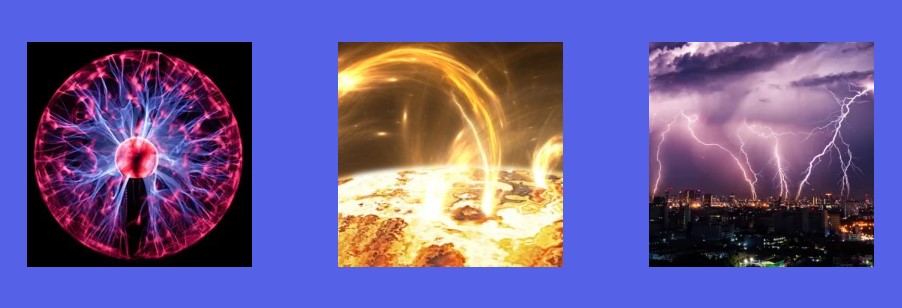Scientific Information about Cold Plasma

Image of Plasma
Plasma is an ionized gas – the fourth state of matter. Plasma is formed when gases are supplied with a large amount of energy, usually due to extremely high temperatures and heat. Plasma occurs naturally – the Sun and all the stars are made of plasma! This means plasma is not rare – most observable matter in the universe is in a plasma state. On Earth, plasma naturally appears as lightning, and it can also be artificially created by using electrical energy to energize a gas.
Although plasma in nature is usually very hot, we can create “cold plasma” by partially ionizing a gas using electrical energy. This allows the creation of plasma at atmospheric pressure and at temperatures safe for humans.

Image of Plasma
Cold plasma consists of a mixture of electrons, ions, atoms and molecules in excited states, reactive agents (e.g., O3, NO, NO2…), light, ultraviolet (UV) radiation, and heat.

Image of Plasma
When combined, these components kill or deactivate bacteria, viruses, and fungi. At the same time, they also stimulate the body’s natural healing processes.
When applied to human skin, the different components of cold plasma work together to simultaneously activate and promote the body’s wound-healing process while killing or inactivating bacteria, viruses, and fungi.
Sterilization
Cold plasma can kill or inactivate bacteria, viruses, and fungi, including antibiotic-resistant strains.
- Ions and electrons bombard the skin surface and break the hydrogen bonds of organic molecules, such as those that make up bacterial and viral cell membranes. Electrons penetrate deepest and can pass through moist layers on the skin. Electrons also react with water to produce reactive oxygen species capable of killing microorganisms. Ions dissolve into water, making it more acidic and less favorable for microbial survival.
- Reactive oxygen species are oxygen atoms and chemical molecules containing oxygen in basic or excited states, as well as their ions. Hydroxyl radicals (OH) react very quickly with organic molecules, removing hydrogen atoms and creating alkyl radicals, which are rapidly oxidized in the air. They destroy the envelopes and cell walls of bacteria, fungi, and viruses, leading to cell death. Hydrogen peroxide (H2O2) is a strong disinfectant that can penetrate the bacterial cell nucleus, where it can damage DNA molecules and kill the cell. Ozone (O3) is a strong oxidizing agent that destroys the cell wall.
- Reactive nitrogen species such as nitric oxide (NO), nitrogen dioxide (NO2), peroxynitrite ion (ONOO−), nitrous acid (HNO2) react less strongly than reactive oxygen species, but they can also penetrate tissues and have antibacterial effects.
- Ultraviolet radiation is highly effective in sterilization. It damages DNA and prevents bacterial replication. However, the Mirari device does not produce significant levels of ultraviolet radiation, as excess UV could harm human skin.
- Heat and visible light are produced only in small amounts. Although these are the only two components humans can directly feel, they have no significant medical effect on the skin.
- Electromagnetic radiation is generated by all electronic devices. This is a harmless byproduct with no side effects.
Promoting the Body’s Natural Healing Process
In addition to sterilizing the skin, cold plasma promotes the body’s natural self-healing mechanism, helping regenerate tissue and maintain healthy skin. Cold plasma has positive effects on:
- The formation of scabs on the skin occurs faster after using cold plasma.
- Tissue regeneration is stimulated by reactive nitrogen species.
- Anti-inflammatory effects – cold plasma has anti-inflammatory properties.
- Collagen regeneration helps reduce scarring.
- Adjusting the skin’s pH – the outer layer of human skin has an acidic protective barrier that prevents dryness. Ions in cold plasma help lower the skin’s pH. This helps reduce atopic dermatitis and supports healthier skin.
It reduces sebum production, significantly decreasing acne.
- Kills or deactivates bacteria, viruses, and fungi
- Safe for direct use on the skin
- Has many beneficial medical applications
- Temperature below 40°C
- Produces no waste
- Can be generated at different frequencies
- Can be generated from ordinary air




